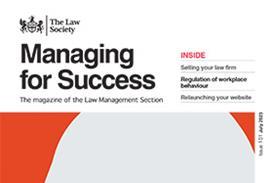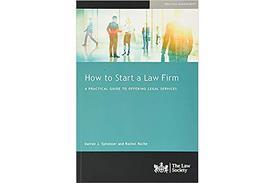Whether they know it or not, lawyers are in the ‘knowledge’ business. Law firms sell their clients solutions to existing or potential problems based on the firm’s combined knowledge and experience, through their advice, representation and advocacy, and their written documents. Lawyers have been managing the knowledge their practices are based on – effectively, ‘doing’ knowledge management (KM) – instinctively, for hundreds of years.

Unfortunately, the legal sector continues to face unprecedented pressures: regulatory changes; strain on fees and increased demands from clients; limitations on public sector work; competition from new market entrants; the involvement of venture capitalists and unbundled service providers; and, of course, technological developments.
Clients instruct law firms not because lawyers have exclusive access to information, but because they have the knowledge and experience to filter it, understand it, analyse it against a particular set of facts, and act upon it in a practical way
General trends towards leaner organisations outside the legal sector have also contributed to increased interest from clients in demonstrable efficiency gains. In order to thrive within this new order, law firms have to increase their strategic use of proven business tools and techniques, such as KM.
This article aims to explain what ‘knowledge’ is, what KM is, and how law firms can begin to take a more strategic approach to improving their business’s efficacy through the strategic KM tools and techniques which have been proven over many years within knowledge-intensive businesses.
What is ‘knowledge?’
Although most lawyers know instinctively what ‘knowledge’ is, it can be helpful when framing strategic KM plans to clarify what the term means within a particular organisation.
‘Knowledge’ has been defined as “a fluid mix of framed experience, values, contextual information, and expert insight that provides a framework for evaluating and incorporating new experiences and information. It originates and is applied in the minds of knowers” (Working Knowledge, T Davenport and L Prusak (Harvard Business School Press, 2000)).
‘Knowledge’ is more than information, and is what clients buy from lawyers: the knowledge that creates solutions for their business or personal problems. In today’s ‘information age’, much of the information on which lawyers base their services (legislation, regulations, case law) is available to everyone. Clients instruct law firms not because lawyers have exclusive access to this information, but because they have the knowledge and experience to filter it, understand it, analyse it against a particular set of facts, and act upon it in a practical way. Clients buy the value that lawyers add to the available information, as well as the reassurance and risk management of using an experienced professional.
What is KM?
There are many definitions; some even say it’s a nonsense – who can ‘manage’ what is known in a mind? However, taking a practical view, KM is at the very heart of law firms. It is how firms create, capture, access, apply, interpret and use the combined knowledge of their employees in pursuit of successful businesses, whatever their niche. This could include:
- knowledge creation through workable, effective training programmes, mentoring, supervision, reflective learning, and encouraging knowledge-sharing;
- efficient workflows, checklists and file-management systems, minimising wasted time, and incorporating relevant aspects of total quality management systems;
- the reuse and exploitation of existing knowledge through precedents, practice notes and knowledge packs, so no one has to reinvent the wheel and then write off time, and outdated knowledge isn’t used by mistake;
- better informed decision-making based on data;
- fee-earner attraction and retention through stripping their roles of repetitive tasks which don’t utilise their specific talents;
- retention of knowledge within the organisation when people leave through redundancy, retirement, or outsourcing;
- efficient knowledge-based marketing (newsletters, seminars, social media), so that the minimum amount of non-chargeable time is spent for the maximum return; and
- facilitating collaboration and networking throughout the firm to improve the flow of knowledge, whether that is technical legal information about cases, legislation and regulation, client information for cross-selling, or experiences and top tips for more successful lawyering.
In Working Knowledge, Davenport and Prusak said: “… the only sustainable advantage a firm has, comes from what it collectively knows, how efficiently it uses what it knows, and how readily it acquires and uses new knowledge.” KM can help firms achieve that advantage. It offers the efficiency, effectiveness and profitability gains necessary to support growth and sustainability, and help firms gain and retain the competitive edge.
In 2004, US research by International Data Corp suggested that Fortune 500 businesses lost $31.5bn through their failure to share knowledge within their organisations.
Is it all about precedents?
There is often much emphasis within law firms on precedents and databases. These can:
- reduce the amount of time fee-earners spend producing documents, thereby improving productivity;
- take care of the repetitive work, supporting leverage and commoditisation and freeing senior fee-earners to concentrate their efforts on complex value-add work;
- help a firm speak in a single house style, avoiding unnecessary jargon and promoting a single branding message; and
- improve quality assurance.
However, precedents and databases are only one aspect of KM. Too many firms assume that, to improve the way knowledge is managed within their firm, they must upgrade their existing precedent databases and/or search tools, or buy more services from online providers. This is a misconception. Knowledge repositories are only part of KM. Once basic document and information retrieval needs are met, most firms can get a greater return on investment by using other strategic KM tools and techniques, rather than investing more in IT.
How can we get started?
Firms need to take a broad approach to KM, looking at all aspects of the knowledge flow within their business, and focusing efforts as required by their business strategy. I recommend that firms begin with the following seven steps.
- Create a designated KM team and chief knowledge officer.
- Train all staff in KM and personal KM, not just professional support lawyers or knowledge lawyers.
- Create a fast-track mini KM strategy, to ensure you begin benefiting from KM tools and techniques immediately.
- Create a full KM strategy, encompassing a knowledge audit, and get this agreed within the business.
- Implement the strategy.
- Embed the strategy in your business, and ensure you have an effective knowledge-sharing culture.
- Keep the KM strategy under regular review and make any changes to ensure effective delivery.
I look in more detail at some elements of this process below. You can find out more about this process in Knowledge Management Handbook, published by Law Society Publishing in 2012. Law Management Section members get 20% off.
Knowledge audit
Point 4 above includes a knowledge audit. A way to get started on this is to review your existing knowledge resources and activities, and assess their practical efficacy, as measured by your frontline fee-earners, against the current and future needs of the business. The ‘Key Resources Framework’ outlined in Managing People and Knowledge in Professional Services Firms (Nicholas Kinnie et al, Chartered Institute of Personnel and Development, 2006) may be useful to analyse your internal knowledge resources.
You also need to look at external factors, by analysing your current level of activity against comparable organisations, and ascertaining whether there is a maturity gap. This will be useful for background information, but remember that your KM strategy supports your business’ strategy, not theirs. You will also need to investigate current and likely future market conditions and pressures. Here, traditional SWOT (Strengths Weaknesses Opportunities Threats) and PEST (Political Economic Social Technological) tools may be useful, as may Porter’s Five Forces and scenario analysis.
Strategy
Once you understand the firm’s internal and market environment, you will need to decide on your overall vision for KM within the organisation, and build this into a strategy. Drawing up a brand new written KM strategy can be a daunting challenge, but it will be worthwhile, as your firm’s existing implicit knowledge strategy is unlikely to be the most effective way to promote your firm’s best interests or reflect its overall business strategy.
A fully thought-out, explicit, written strategy will act as an ongoing, live business case, helping to justify expenditure of time and money. It will ensure everyone in the firm understands the strategy and reasoning behind it, and focuses knowledge resources on the most strategically important aspects – those which minimise any wastage of time and resources, and have the highest pay-off. Finally, it will help your implementation plans to stay on track, providing a clear framework for action, and avoiding anyone being tempted into inefficient expenditure.
You need to work with a wider group than just your fee-earners for this process to be successful. Although the views of your fee-earners will be useful, they are unlikely to have sufficient information and experience of all the available KM tools and techniques, nor the return on investment (ROI) of each one, to be your main source of ideas for improvements. For example, one important aspect of KM is connections and knowledge-sharing, through, for example:
- creating knowledge maps and directories, so the right person can easily be found;
- improving opportunities for networking and collaboration;
- mixing teams up for training sessions;
- improving social opportunities;
- ‘ask an expert’ coffee mornings;
- ‘randomised coffee trials’ (a form of organised random conversations – for more details, see my blog at tinyurl.com/lu4e2eh);
- knowledge fairs; or even
- Japanese-style ‘talk rooms’.
KM experts understand the value of connecting people and the ROI to the firm; it builds trust for future knowledge-sharing, and sparks new ideas and innovations. However, fee-earners often struggle to see the value in any task which isn’t obviously chargeable.
To get an appropriate breadth of vision, both for the knowledge audit and strategy work, you may need to establish a representative steering group to consider these points, and then pass the initial document through a wider group before finalising it.
Although with some additional research and training in KM you will probably be able to undertake much of this work yourself, if you haven’t much KM experience, you may find that an outside expert, with experience of a myriad of potential KM strategies and an understanding of the return likely from each, will be more cost-effective.
Make your strategy’s objectives SMART (specific, measureable, achievable, realistic and time-bound) and keep them simple.
This whole process can take time, so in the meantime, consider drawing up and implementing a ‘mini strategy’, for some quick wins – see the box (above) for details.
A mini strategy
There is a major risk in writing strategies that the process of strategising becomes an end in itself, and valuable time for improvement can be lost to researching, analysing, defining and refining. This is where a fast-track, mini strategy can come in. This involves comparing existing KM activity against business strategy, and improving practices accordingly, straight away. A mini strategy can take any shape and use any format, but questions to get you started could include the following.
- What are your business’s top three key objectives over the next five years?
- How do current knowledge activities support these objectives within each team or department?
- What budget and manpower do you have available for existing KM work and future projects?
- What simple changes can you make to fill gaps in KM support for business objectives? How can you leverage existing systems to fulfil KM needs?
- What large-scale changes to KM may be needed to fulfil these business objectives? What will you need to know in order to analyse possible solutions?
Implementation
Make sure you spend as much time on implementation and change management plans as you do on the initial audit. Embedding the changes necessitated by the strategy is often overlooked, but is just as important as choosing the right KM tools and techniques initially.
Prioritise any quick wins and leverage any technology you already have. Don’t put off an important task looking for the perfect solution: implement a good ‘work in progress’ approach and review it as appropriate.
Refer to the strategy whenever you start or complete a project, are asked to broaden your workload, or review your budget / departmental spend, so that you can keep your objectives in mind and focus on those tasks which promote your strategy. Make your strategy a living document that you refer to regularly and adjust as required. If your strategy must be in a particular style for your executive board, consider having an additional short, plain English ‘roadmap’ for everyday use. Many people find it useful to have a short summary pinned near their desk or somewhere easily accessible.
Review
Establish a KM strategy review schedule, depending upon your objectives and the changing economic landscape. The KM strategy can provide the vision, but as the world changes, you will need to adapt your implementation programme.
Knowledge-sharing culture
Creating a culture where collaboration and knowledge-sharing is simply ‘how things are done around here’ is a difficult task, and one with which the majority of law firms struggle. It is a topic that is frequently discussed at KM conferences and at my own networking and knowledge-sharing group (Knowledge Network West). Once your KM strategy is in place and you have improved the basic level of knowledge flow through your firm, you will probably obtain a greater ROI by focusing on knowledge-sharing rather than continuing to improve knowledge databases and search functions.
I recently researched knowledge-sharing antecedents for my MBA dissertation. There isn’t sufficient space here to explain the details of my research, results and conclusions, but if you are interested, there is more information on my blog at tinyurl.com/pla5fce, and in my article ‘Intrinsic vs. extrinsic: Motivations for knowledge sharing in law firms’ (Managing Partner, 26 March 2014).
Further reading
- Business Information Management (Pearson Education Ltd, 2008)
- Working Knowledge: How Organizations Manage What They Know (Harvard Business School Press, 1998)
- Effective Knowledge Management for Law Firms (Oxford University Press, 2004)
- The Complete Idiot’s Guide to Knowledge Management (CWL Publishing Enterprises, 2002)
- Knowledge Management Handbook (Law Society Publishing, 2012)


















